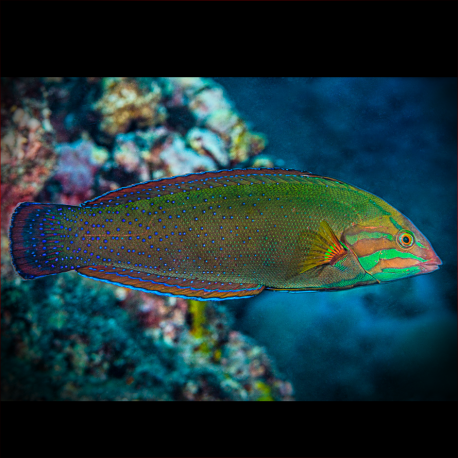More info
Datasheet
| Minimum Tank Size | 1500 litres / 396.26 US gallons |
| Maximum Size | 38.0cm / 14.96inches |
| Reef Compatible | Not reef safe |
| Temperament | Might be aggressive towards other species |
| Temperature | 22.2°C / 71.96°F - 25.6°C / 78.08°F |
| Specific Gravity | 1.020-1.025 |
| Carbonate Hardness | 8-12 |
| pH | 8.1-8.4 |
General Description
Rainbow Wrasses, scientifically known as Coris cuvieri, are a species belonging to the Labridae family. They undergo a striking transformation in appearance from their juvenile to adult stages. These fish have the habit of burying themselves in the tank substrate for sleep or protection, necessitating a substrate depth of around 2-4 inches (5-10 cm) depending on their size.
Aquarium Suitability
Rainbow Wrasses are deemed suitable for aquariums but come with specific care requirements and demands due to their growth potential. When fully grown, these fish require a significantly large aquarium, making them challenging to house in home setups. They can pose a threat to smaller fish, crustaceans, sea urchins, and even feed on clams in an aquarium setting.
Care and Hardiness
Known for their hardiness, Rainbow Wrasses can adapt well to aquarium conditions when introduced at a juvenile stage. They are hermaphroditic, with the ability to change gender from female to male. These fish prefer to hide initially when acclimating and may rearrange rocks and substrate in the tank, requiring stable rock placements. They thrive on a varied diet and need ample space for swimming due to their active nature.
Reef Suitability
Rainbow Wrasses are not considered reef-safe due to their hunting behavior, which includes preying on invertebrates like flatworms, pyramid snails, and small crustaceans in a reef aquarium. Their inclination to forage under loose objects can lead to disruptions in a reef setup if not managed properly.
Aquarium Setup
Setting up an aquarium for Rainbow Wrasses involves providing a deep sandy substrate for burrowing, stable rock structures, and ample swimming space. A minimum tank size of 1500 liters is recommended to accommodate their growth potential. Ensuring the area around their mouth is undamaged during transportation and allowing them the opportunity to burrow are essential considerations.
Behaviour
Rainbow Wrasses exhibit a territorial and potentially aggressive temperament towards other species, especially smaller fish. They tend to hunt for food beneath loose objects and showcase digging behavior as part of their natural instincts.
Feeding and Diet
These wrasses have a diverse diet that includes larger crustaceans, other invertebrates, and small crustaceans like krill, mysis, and artemia. It is crucial to provide them with a varied diet to meet their nutritional needs and maintain their health in captivity.
Habitat and Distribution
Natively found in the Indian Ocean, specifically in regions like the Red Sea, the southern Arabian Peninsula, and extending to locations such as Zanzibar, South Africa, and the eastern Andaman Sea, Rainbow Wrasses inhabit sandy substrates and rocky areas in coastal waters.

